Community works to move beyond vandalized bridge
After Port Alberni is flooded with Orange Shirt Day support,
By James Paracy and Eric Plummer Ha-Shilth-Sa Contributor and Editor
PortAlberni, BC - In a small city that can be seen as a microcosm of Canada’s movement towards reconciliation with Indigenous peoples, PortAlberni’s residents poured onto its streets Sept. 30, clad in orange to mark the day of recognition.
But during the evening of the second annual National Day for Truth and Reconciliation, a collective spirit of understanding and support became tainted when an “Every Child Matters” slogan painted on a PortAlberni landmark was vandalized with a racist slur.
Just days earlier former students from theAlberni Indian Residential School and children currently attending Haahuupayak Elementary painted parts of the bridge across the Somass River, leading to the Tseshaht First Nation’s reserve. Sections of the structure are now orange, recognizing the colour worn to honour survivors of the assimilationist practices of the residential school system, complete with the slogan across the bridge’s roadside barrier.
Coincidentally, many locals still refer to the structure as “The Orange Bridge”, recalling its colour for decades before being painted grey in 1990.
Hundreds crossed the newly painted Orange Bridge on Sept. 30, reaching the nearby former site of theAlberni Indian Residential School for a gathering to complete the cross-city walk for reconciliation. But by 10 p.m. that evening Tseshaht Chief Councillor Ken Watts began hearing reports that the bridge slogan had been vandalized.

“Although this type of act does not come as a surprise to many, it is a sad reminder of the depth of work we, as a community and broader society, have in front of us to eliminate racism,” reads a statement released by the First Nation the following day. “Our Nuu-chah-nulth teaching of ḥačatakin cawaak reminds us that everything is one and all is connected.”

As a child, Wally Samuel attended AIRS. TheAhousaht elder took part in painting the bridge orange before the national day of recognition.
“It’s sad that somebody vandalized that, we’re not blaming any race or anything, it’s just some idiot individuals,” said Samuel, noting that PortAlberni has become a more accepting community than it was in the 1950s and ‘60s. “There’s still some idiots out there, but it’s up to us to educate them and still act respectfully.”
The PortAlberni RCMP are investigating the vandalism and ask the public for
any information about the culprits.
“Senseless acts such as this are unacceptable and troubling to our community, and revert the efforts towards truth and reconciliation,” stated Const. Richard Johns, RCMP media relations officer. “Although this crime was not reported to our detachment officers are actively investigating any available leads.”
Over the weekend the incident made national news, giving bad publicity to a city that has worked in recent years to overcome an intolerant past.A.W. Neill wasAlberni’s MLAaround the turn of the century, followed by being elected mayor in 1916 and serving as member of parliament for Comox-Alberni from 1921-1945. The long-time federal representative also served as an IndianAgent, enforcing the assimilationist laws of the IndianAct in the region, and advocated for the internment of Japanese-Canadians during the Second World War. Meanwhile on the west side of the Somass River, a residential school took in First Nations children from across coastal and central B.C. for nearly a century.
In a statement on her Facebook account, PortAlberni Mayor Sharie Minions condemned the vandal’s racist actions, emphasizing a need for the community to stick together.
“While we have made great strides, this act shows how much work there still is to do within our community. Reconciliation, relationships, learning and understanding have never been more important,” wrote Minions.
Community members, both Indigenous and non-Indigenous, came to the site to clean up the vandalism, and by the time the sun hit the Orange Bridge on Saturday the slogan was restored to its original state.

“Survivors felt it would be fitting to paint the bridge orange to symbolize resilience, hope for the future and to raise awareness of the impacts of residential schools so that the pain they’ve endured never happens again,” stated the Tseshaht.
“We’ve got to be ready to share our story,” said Samuel, noting that some of his schoolmates are still unable to cross the bridge. “They knew crossing that bridge meant heading to the residential school.”
Following a wave of investigations into burials at former residential school sites, the Tseshaht undertook radar scanning this summer for unmarked graves where AIRS once stood, the first phase being completed Sept. 23. Meanwhile the First Nation brought forward the idea of painting the bridge to their working group of
newly painted bridge is marked by a racist slur
residential school survivors, in an effort to ensure the children who attended the institution won’t soon be forgotten.
Costs for the project seemed quite high at first according to Watts, but things came together after some discussion and planning with the B.C. Ministry of Transportation and Infrastructure. Initially the idea was to paint the entire bridge, but with the Somass being a salmon bearing river, painting the bases around the bridge emerged as the safer compromise.
The ministry took their support a step further and donated the orange paint and roadside flaggers for the day.
“The ministry is grateful to have had the opportunity to partner with the Tseshaht First Nation and Mainroad Mid Island to add orange to the Orange Bridge as a way of honouring residential school survivors and all those who did not survive,” said PublicAffairs Officer Gene Law on behalf of the Ministry of Transportation and Infrastructure.
With a little help from Tseshaht and the
custom print shop Billybeauty to make the “Every Child Matters” sign, the job was done. This gives the community and tourists passing through a lasting reminder to remember the children taken from their families and sent to residential schools.
“Seeing survivors and children paint was amazing, it was a day that I’ll never forget,” said Watts.
For Wally Samuel, reconciliation means people from different backgrounds learning how to better understand each other and live together.
“It’s getting better because our kids are growing up with other nations,” he said, adding that reconciliation amongst First Nations is part of the movement as well.
“We have to reconcile with everybody.
We had a lot of tension between our own nations before, between families.”
“No matter what race you’re from, we’re all human beings and we’ve got to work together to make a better safer place for everybody,” added Samuel.
Canada’s Oldest First Nations Newspaper - Serving Nuu-chah-nulth-aht since 1974 Vol. 49 - No. 19—October 6, 2022 haas^i>sa Canadian Publications Mail Product Sales Agreement No. 40047776 INTERESTING NEWS If undeliverable, please return to: Ha-Shilth-Sa P.O. Box 1383, PortAlberni, B.C. V9Y 7M2Inside this issue... Kennedy Hill project 90 per cent finished......................Page 2 Nuchatlaht returns to court.............................................Page 3 Woman videos mysterious phenomenon................Page 7 Science of smokehouses...............................................Page 11 Indigeous podcast about misinformation......................Page 15
a
Photo submitted by Ken Watts ChuckAugust helps paint the bridge over the Somass River orange, an initiative organized by the Tseshaht before the National Day for Truth and Reconciliation.
Kennedy Hill Improvement Project 90 per cent finished
Project goes nearly $16 million over budget after more than four years, finishing touches planned for the winter
By Karly Blats Ha-Shilth-Sa Contributor

Kennedy Lake, BC - The Highway 4 – Kennedy Hill Improvement Project remains slated to be substantially complete this fall, with finishing touches outside of the roadway continuing throughout the winter.

Drivers travelling on Highway 4 can still expect delays as the road improvement project enters the final stages of construction. The project is approximately 90 per cent complete.
According to the provincial government, throughout the fall, hourly road closures, with top-of-the-hour releases, will take place daily from 5 a.m. until 3 p.m. and from 7-11 p.m. Single-lane alternating traffic will be implemented seven days a week from 3-7 p.m. and nightly closures will continue to take place from 11 p.m. until 5 a.m., with a release to clear queued traffic at 2 a.m.
Hourly closures will provide crews with up to 45-minute work windows throughout the day, speeding up work on road profile blasting, rock and slope stabilization, foundation building for cantilever structures and other work.
Safety improvements over the 1.5-kilometre project length include widening the highway to accommodate two full lanes and paved shoulders, horizontal realignments to the highway to remove the sharp blind corners, as well as blasting and excavating bedrock to eliminate existing overhanging rock above the road surface.
Improvements will also include the addition of a rest area with a viewpoint on
The project budget has been increased to $53.96 million from $38.1 million and includes $13.5 million in federal funding under the New Building Canada Fund.
According to the province, several factors increased the project budget and delayed completion. These include the COVID-19 pandemic, repairs to Highway 4 resulting from blasting damage at the project site in January 2020, increased environmental protections and the need for smaller blasts due to the nature of the
fractured bedrock.
“Increased environmental protections were established for a small tributary stream that was initially identified as nonfish bearing at the onset of construction.
It has since been protected as fish-bearing,” said the Ministry of Transportation and Infrastructure (MoTI). “Other small drainage sites were identified where further restorative planting and settlement pond containments were established to maintain runoff water quality.”
The ministry said the most challenging element of the project has been the need for small, high-precision blasting “to protect the sensitive environmental habitat
of Kennedy Lake and critical overhead utility infrastructure that serves people who live in or visit Tofino, Ucluelet, and the surrounding area.”
The Kennedy Hill project, which began work in the spring of 2018 and was originally set to be completed in 2020, has faced difficulties with rock blasting. When finished, the project will provide a wider, straighter route along Highway 4. the lake side of the new highway, with an intersection to access the facility by passenger vehicle, RV, bus, and transport truck.
According to the MoTI, this blasting process removed more than 180,000 cubic metres of rock more than 50 metres high along 1.5 kilometres of highway.
“The Highway 4 – Kennedy Hill Safety Improvement project will make the road safer and easier for people who live and visit special destinations like Tofino and Ucluelet, stimulating economic development and tourism opportunities,” said the MoTI.
Page 2— Ha-Shilth-Sa—October 6, 2022
Photo by B.C. Ministry of Transportation and Infrastructure
Nuchatlaht return to court for trial’s final arguments
Province stresses First Nation’s historical reliance on ocean resources, rather than using land being contested
By Eric Plummer Ha-Shilth-Sa Editor
Vancouver, BC - The Nuchatlaht returned to court on Sept. 27, for the final arguments in the firstAboriginal title case since the provincial government passed into law an act recognising the inherent rights of Indigenous peoples.
After a summer away from the courtroom legal teams representing the small Vancouver Island First Nation and the province returned to the B.C. Supreme Court, where Justice Eliot Myers is scheduled to hear the final arguments over three weeks.
The Nuchatlaht First Nation’s claim to the northern half of Nootka Island was first submitted to the B.C. Supreme Court in early 2017. The case eventually went to trial on March 21 of this year, extending for over 40 days in court for the presentation of evidence until May 26. After reviewing the facts presented, final arguments were assembled and filed to the court this summer.
The case entails the Nuchatlaht seeking legal recognition – under Canadian law - of their territory on Nootka Island, an area comprising 20,000 hectares off the northwestern side of Vancouver Island. This is currently designated Crown land, with a forestry tenure held by Western Forest Products.
The case hinges on the Nuchatlaht’s legal team proving occupation of this area that dates back to 1846, which is the year the British Crown asserted sovereignty in the region. The First Nation has stated that its ties to the claim area have been unbroken for centuries, as evidenced through the hereditary system of governance that extends to the current Tyee Ha’wilth Jordan Michael. Its legal argument detailed a confederacy of at least half a dozen tribes that occupied northern Nootka Island in 1846, who were ancestors of the present day Nuchatlaht.
Meanwhile, the province has argued that at the time of British sovereignty, a loosely affiliated collection of Indigenous groups who were not necessarily directly related to the Nuchatlaht could be found in the claim area. These people relied on the ocean’s resources far more than what could be acquired inland, according to the province’s statement of claim.
“The Nuchatlaht at the date of sovereignty and at all material times relied mostly on marine resources and used up-
Nuchatlaht members and other Nuu-chah-nulth-aht sing on the front steps of the B.C. Supreme Court on Sept. 27, before their land title trial resumed for final arguments. The Nuchatlaht are seekingAboriginal title for northern Nootka Island.
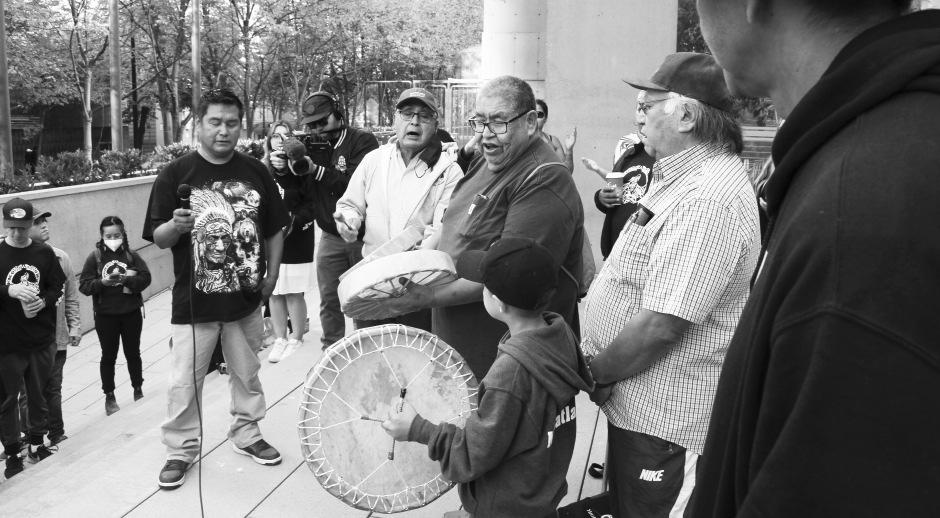
land areas to a limited extent,” stated the province. “The claim area includes pervasive geographic features which historically and at the date of sovereignty and at all material times limited or prevented access, use and occupation by the Nuchatlaht, such as areas of high elevation, steep and densely forested upland areas, and steep rocky, exposed shorelines.”
The First Nation’s legal team presented expert witnesses to prove otherwise, with reports and testimony given by archaeologists John Dewhirst and Jacob Earnshaw, who investigated the prevalence of culturally modified trees and indentations of houses that were once found in the claim area.
But one expert witness had to be dropped due to the cost of extending the trial. Ethnobotanist ChelseaArmstrong was expected to present evidence of cultivation in the area, but she was not part of the trial due to the province lining up three witnesses to respond to her one report, said Owen Stewart of the Nuchatlaht’s legal team. This presentation and response would have added another two to four weeks to the trial, he said, an expensive duration in court for a First Nation with 167 members. Trial briefs that were submitted before the parties went to court indicates a disparity in how long each side was prepared to be before
Ha-Shilth-Sa Newspaper welcomes a new reporter
PortAlberni, BC - The NTC and the HaShilth-Sa department are pleased to welcomeAlexandra Mehl into the reporter position, effective September 28, 2022. Alexandra has recently moved from Victoria, where she graduated from Professional Writing in Journalism and Publishing, as well as Gender Studies, at the University of Victoria in December. Alexandra served as a senior staff writer at the Martlet, the University of Victoria’s newspaper. Her experience also includes a position as digital media manager at the Canadian Centre for Men and Families Alberta, and is founder of Story-weaving, a project that writes and publishes people’s life stories in the form of bound books.

the judge: the Nuchatlaht expected 43 days in court, while the province was ready for 66.
Ironically, midway through the first two months of the trial the provincial government announced new directives for its lawyers to avoid expensive court battles with First Nations. This approach better aligns with the Declaration on the Rights of Indigenous People’sAct, which passed through the B.C. legislature in November 2019.
“Meaningful reconciliation is rarely achieved in courtrooms,” stated the directives, which were released onApril 21.
These directives also specify that the attorney general can intervene in court proceedings “that may affect reconciliation,” but David Eby has refused to do so, or even comment on the case.
“The province has considered its pleading in the context of the directives and at this time we’re not intending amendments,” said provincial lawyer Jeff Echols in a court transcript fromApril 21.
When DRIPAwas passed in late 2019, the United Nations Declaration of the
Rights of Indigenous Peoples was formally adopted into B.C. law.Article 26 of this international declaration states “Indigenous peoples have the right to own, use, develop and control the lands, territories and resources that they possess by reason of traditional ownership or other traditional occupation or use, as well as those which they have otherwise acquired.”

Aboriginal title over northern Nootka Island will benefit future generations of Nuchatlaht people, with housing opportunities, salmon parks, forest restoration and sustainable land use, according to a recent press release from the First Nation.
“Nuchatlaht leaders are looking to restore their stewardship of the area after decades of environmental mismanagement,” stated the release. “Reclaiming title to Nootka Island will enable the Nuchatlaht Nation to pursue an ambitious vision for the future of Nuchatlaht people – one that will see benefits far beyond Nuchatlaht.”
Looking for......
Usma Nuu-chah-nulth Family and Child Services are looking for individual/s or families who are interested in caregiving for teens with high-risk behaviors.
The Caregiver(s) would provide 24-hour care in a culturally safe and suppor!ve environment, responding effec!vely to challenging behaviours.
Compensa!on would be built around the specific needs of the youth and the Caregiver, and could include both direct services and financial support to allow Caregivers to meet the needs of the youth.
For more informa on, please call Joni or Julia at 250-724-3232.
October 6, 2022—Ha-Shilth-Sa—Page 3
WelcomeAboardAlexandra!
Photo by Eric Plummer
Ha-Shilth-Sa newspaper is published by the Nuu-chah-nulth Tribal Council for distribution to the members of the NTC-member First Nations, as well as other interested groups and individuals.
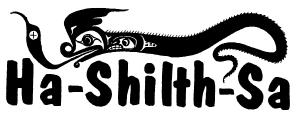
Information and original work contained in this newspaper is protected by copyright and may not be reproduced without written permission from:
Nuu-chah-nulth Tribal Council
P.O. Box 1383, PortAlberni, B.C. V9Y 7M2.
Telephone: (250) 724-5757 Fax: (250) 723-0463 Web page: www.hashilthsa.com facebook: Hashilthsa Ntc
2022 Subscription rates: $35 per year in Canada and $40 per year in the U.S.A. and $45 per year in foreign countries. Payable to the Nuu-chah-nulth Tribal Council.
Manager/Editor/Reporter
Eric Plummer (Ext. 243) (250) 724-5757 Fax: (250) 723-0463 eric.plummer@nuuchahnulth.org
Reporter
Denise Titian (Ext. 240) (250) 724-5757 Fax: (250) 723-0463 denise.titian@nuuchahnulth.org
Reporter
Alexandra Mehl (Ext. 286) (250) 724-5757 Fax: (250) 723-0463 alexandra.mehl@nuuchahnulth.org
Audio / Video Technician
Mike Watts (Ext. 238) (250) 724-5757 Fax: (250) 723-0463 mike.watts@nuuchahnulth.org
EditorialAssistant Holly Stocking (Ext. 302) (250) 724-5757 Fax: (250) 723-0463 holly.stocking@nuuchahnulth.org
DEADLINE:
Please note that the deadline for submissions for our next issue is October 14, 2022
After that date, material submitted and judged appropriate cannot be guaranteed placement but, if material is still relevant, will be included in the following issue.
In an ideal world, submissions would be typed rather than hand-written. Articles can be sent by e-mail to holly.stocking@nuuchahnulth.org (Windows PC).
Submitted pictures must include a brief description of subject(s) and a return address.
Pictures with no return address will remain on file.Allow two - four weeks for return.
Photocopied or faxed photographs cannot be accepted.
COVERAGE:
Although we would like to be able to cover all stories and events, we will only do so subject to:
- Sufficient advance notice addressed specifically to Ha-Shilth-Sa.
- Reporter availability at the time of the event.
- Editorial space available in the paper.
- Editorial deadlines being adhered to by contributors.
LETTERS and KLECOS
Ha-Shilth-Sa will include letters received from its readers. Letters MUST be signed by the writer and have the writer’s full name, address and phone number on them. Names can be withheld by request.Anonymous submissions will not be accepted. We reserve the right to edit submitted material for clarity, brevity, grammar and good taste. We will definitely not publish letters dealing with tribal or personal disputes or issues that are critical of Nuu-chah-nulth individuals or groups.
All opinions expressed in letters to the editor are purely those of the writer and will not necessarily coincide with the views or policies of the Nuu-chah-nulth Tribal Council or its member First Nations. Ha-Shilth-Sa includes paid advertising, but this does not imply Ha-Shilth-Sa or Nuu-chah-nulth Tribal Council recommends or endorses the content of the ads.
Treaty commission celebrates 30 years
Treaty nations reflect on economic self-sufficiency after many years of negotiations
By Denise Titian Ha-Shilth-Sa Reporter
Vancouver, BC – The Emerald Room of the Fairmont Pacific Rim Hotel in downtown Vancouver was packed with treaty teams from First Nations as well as the federal and provincial governments as the BCTC marked 30 years of treaty-making in the province.
The B.C. Treaty Commission’s mandate is to be the independent facilitator of negotiations amongst First Nations in B.C., the Government of Canada and the Province of British Columbia. They allocate support funding to enable First Nation participation in the negotiations and provide public information and education about the treaty process.

In their negotiation update, the BCTC said that the B.C. treaty negotiations process is voluntary and open to all First Nations in British Columbia. Since the beginning of the modern-day treaty process, there have been 65 self-determining First Nations that have entered, participated in, or have completed treaties through the negotiations process.
BCTC goes on to say that active or completed negotiations involve 39 selfdetermining First Nations, representing 72 current or former IndianAct bands, totaling 36 per cent of all IndianAct bands in B.C. For statistical purposes, the Treaty Commission continues to refer to “IndianAct bands” to provide a common reference point.

According to Statista, there were 199 IndianAct bands in British Columbia, the highest number of all the provinces in Canada, before the modern-day treaty process. Eight of those have achieved modern day treaties with a few more nearing final stages of treaty negotiation.
On Sept 21, the BCTC celebrated B.C. modern treaties by marking the 30th anniversary of the signing of the BCTC Agreement.
In a written statement, Premier John Horgan congratulated the B.C. Treaty Commission and all participants on their successes.
“I honour and acknowledge the courage and dedication of our treaty partners: the Tla’amin Nation, Tsawwassen First Nation, Maa-nulth Treaty Nations (Huu-ay-aht First Nations, Ka:’yu:’k’t’h’/
Che:k:tles7et’h’First Nations, Toquaht Nation, Uchucklesaht Tribe, and Yuułuʔiłʔatḥ Government) and Nisga’a Nation,” he stated.
In his opening comments, Howard Grant of Musqueam spoke of the growth and revival of culture and language through reconciliation efforts.
“Thirty years ago, we embarked on the road to modern-day treaties.At that time, we said we’d be done in 10 years,” he chuckled, noting there were several heads of silver hair in the room. “Today, we look to the successes of those that have achieved treaty.”
Grant noted that the government push for modern-day treaties came as a result of First Nations’successes in landmark court cases.
“Delgamuukw, Tsilhqot’in, Sparrow, is what brought us to modern day treaties,” he added.
Stephen Point, a former lieutenant governor of B.C. and chief commissioner with the treaty commission, also congratulated BCTC for reaching many milestones. He recalled facing media questions at the 1992 BCTCAgreement signing.
“She (a reporter) was asking, ‘Why are you Indians so upset? Why are you still fighting? We’ve treated you so well, we haven’t killed you all’,” Point shared. Sadly, said Point, that attitude still exists for some.
“We’ve seen international recognition of our rights to self-governance,” he noted.
Edward John recalled that many First Nations left the treaty negotiation table, concerned about the mounting debt.At that time, First Nations had to borrow money in order to engage in treaty negotiations with BC and Canada.
“Perry Bellegarde met with the Prime Minister to talk about loan forgiveness… we shouldn’t have to pay to negotiate our inherent rights,” said John. Two years after that meeting those loans were forgiven or reimbursed to the tune of $1.4 billion.
“Since 2017, First Nations, Canada and B.C. have been exploring flexible approaches, better suited to addressing the needs of the individual nations, and we have shifted the concept of ‘final agreements’to allow room to grow and change over time,” said Premier Horgan. “To-
gether, we have built a shared decisionmaking chapter in treaties that implements the goals of the declaration act on the rights of Indigenous peoples and the United Nations declaration, and we will be closing some treaties shortly.”
Former B.C. premier Mike Harcourt (1991-1996) said he was honored to be there in 1992 with former prime minister Brian Mulroney at the signing of the BCTCAgreement.
“It is most important to build respectful, new relationships,” he said, adding that the time had come that the province could no longer deny responsibility by clinging to the belief that Indigenous matters were solely a federal responsibility.
He recalled the early days when he worked with Indigenous leaders Sophie Pierre, Joe Matthias, George Watts, Miles Richardson and Ed John.And he acknowledged the successes that came after decades of work from all parties.

“Forty years later we have self-governing First Nations who are economically self-sufficient, their cultures almost destroyed are brought back,” said Harcourt.
“I’m proud to witness this wonderfully positive experience.”
“We are becoming who we should have been,” said Huu-ay-aht Councillor John Jack, adding that now, they have the ability to create the change that is needed.
The BCTC blanketed honoured guests and offered lunch and dinner as guests swapped stories about the early days of treaty negotiations.
Legal Information
Ha-Shilth-Sa belongs to every Nuu-chah-nulth person including those who have passed on, and those who are not yet born.Acommunity newspaper cannot exist without community involvement. If you have any great pictures you’ve taken, stories or poems you’ve written, or artwork you have done, please let us know so we can include it in your newspaper. E-mail holly.stocking@nuuchahnulth.org. This year is Ha-Shilth-Sa’s 48th year of serving the Nuu-chah-nulth First Nations. We look forward to your continued input and support. Kleco! Kleco!
The advertiser agrees that the publisher shall not be liable for damages arising out of errors in advertisements beyond the amount paid for space actually occupied by the portion of the advertisement in which the error is due to the negligence of the servants or otherwise, and there shall be no liability for non-insertion of any advertisement beyond the amount paid for such advertisements
Page 4— Ha-Shilth-Sa—October 6, 2022
Mike Harcourt
Mental health aid recommended for repeat offenders
Panel says supports for post-release period critical to curb incarcerations, as First Nations face escalating rates
By Karly Blats Ha-Shilth-Sa Contributor
Improving mental health supports when dealing with repeat criminal offenders and random violent attacks is at the forefront of an expert-led report that provided 28 recommendations to the provincial government.
Expert consultantsAmanda Butler and Doug LePard say the recommendations should help keep people and communities safe by connecting repeat offenders with the supports they need to break out of that cycle.
The investigation makes recommendations in several areas, such as improving the system of care for people in the criminal justice system with mental-health and substance-use challenges, creating more opportunities to divert people from the criminal justice system, and improving services for Indigenous Peoples.
The 14-page executive summary— A Rapid Investigation into Repeat Offending and Random Stranger Violence in British Columbia—was completed in 120 days and done in consultation with a variety of stakeholders including police, mayors and city officials, health authorities, crown counsel, community agencies and academics.
The report states that many voices are missing from consultations, mainly input from Indigenous communities.
“Consultation with Indigenous communities requires relationship and trustbuilding, which takes time and resources that were unavailable as part of this rapid review,” states the report. “We want to acknowledge and stress that Indigenous Peoples in Canada continue to be disproportionately impacted by harms associated with and perpetrated by the criminal justice system as well as prohibitionist drug policy.”
Rising First Nations incarcerations
According to Statistics Canada,Aboriginal people account for 5.9 per cent of B.C.’s population, but in 2017/18 they represented 32 per cent of custody admissions. This shows a marked growth from a decade earlier, when 22 per cent of those brought into custody were Indigenous.
For all recommendations included in the report, the expert panel say the relevance and appropriateness for Indigenous clients must be considered and that any action taken by the province in response to the report should align with the BC Government’s obligations under the Declaration on the Rights of Indigenous PeoplesAct and its commitment to the implementation of the BC First Nations Justice Strategy (BCFNJS).
The report gives many examples that have contributed to individuals breaking the law repeatedly or acting out violently.
Mental Health and substance-use challenges was cited as a major factor in random violent attacks.
“BC Corrections and Correctional Health Services staff have seen an increase in the complexity of mental health issues among people admitted to custody,” states the report. “We heard that people in custody continue to be underserved, particularly with respect to access to psychologists and psychiatrists.”
The expert panel identified a shortage of resources to help people after they are released from incarceration, therefore becoming a crisis that they say must be improved.
“Many people return to precarious hous-
ing, shelters or homelessness, and back to communities where they are at high risk of returning to crime because their needs remain unmet by the systems that should be supporting them,” states the report.
“Having a concrete plan and supports for the post-release period is critical for sustaining any health gains that may have been made while people are in custody.”
Mental illness, substances tied to stranger attacks
Unprovoked stranger attacks have been a concern particularly in Vancouver and Victoria. In Vancouver, stranger attacks in 2021/2022 increased by 35 per cent compared to 2019/2020, coinciding with the onset of the pandemic.
The investigative panel say some of the incidents have been extremely violent and the subject of extensive media coverage.An analysis of 40 cases indicates most suspects have serious mental illness or substance use, or both.
The use of stimulant drugs like methamphetamine, which may cause hallucinations and paranoia, is associated with an increased risk of violence compared to other drugs, states the report.
Stakeholders confirmed that the number of people with methamphetamine induced psychosis has “skyrocketed” in emergency departments across B.C., coinciding with the BC Centre for Disease Control’s reports of increased use of the drug.
The report goes on to say that repeated nonfatal overdoses are resulting in increasing rates of acquired brain injury and “research has robustly demonstrated that aggression and agitation are common consequences of brain injury.”
Several of the recommendations urge the province to implement better mental health and substance use supports for individuals caught in the criminal justice system.
“We recommend that every Provincial Court be assigned a dedicated forensic psychiatric nurse,” states the experts.
“The nurse can support immediate client psychiatric assessments and recommend diversion opportunities in both traditional and specialized court settings. The nurse can also recommend fitness and Not Criminally Responsible onAccount of
Mental Disorder (NCRMD) assessments, to be conducted in community or at the forensic psychiatric hospital.”
It is also recommended that the province consult with LegalAid BC and the criminal defence bar in B.C. on how to improve access to treatment for clients with mental health and substance use needs.
“We recommend that the Provincial Government continue to work with BC First Nations Justice Council and Métis Nation BC to ensure future investment and expansion of the Indigenous Courts, First Nations Courts as well as development of First Nations justice institutions,” reads the recommendations.

Calls to drop ‘prolific offender’term
The BCFNJC made recommendations to the panel, including having the term ‘prolific offender’abandoned by the government as they say it perpetuates harm and stigma, centring harm reduction efforts on the underlying systematic issues, as well as having a new process of consultation put in place that involves other Indigenous organizations, front-line workers and people who commit crimes.
The BCFNJC also recommends that $100,000 should be granted for the design of its pilot program in Prince George’s Indigenous Justice Centre to address the issue of criminal recidivism amongst First Nations people.
“BCFNJC was pleased to see that the panel included all five of our recommendations,” said the justice council in an interview for the Ha Shilth Sa. “Notably, we were pleased to see that the panel rejected the term ‘prolific offender.’The term itself derives from police service agencies’use across the province - it has no legal definition.”
The BCFNJC believe the expert recommendations are promising because they suggest a movement away from police as the dominant service provider for “already marginalized communities.”
“We were also pleased to see the recommendation for B.C. to invest in the design of a BCFNJC-led pilot to serve the unique needs of First Nations who experience repeat contact with the justice
system,” said the justice council. “It was also validating to see the recommendation related to investment and expansion in First Nations Courts and First Nations justice institutions. Time will tell as to whether the recommendations will have an impact on our people, but the report itself was a promising first step.”
The BCFNJC said they won’t know if these recommendations will work for Indigenous individuals yet, but they believe that if First Nations are involved with developing and applying solutions, they will be informed by cultural safety, humility and will be trauma informed.
“Simply put, the colonial justice system has failed Indigenous peoples. When people cannot provide for themselves and experience chronic poverty, they may be vulnerable to interactions with the criminal justice system,” said the BCFNJC.
“The fact that we have a BC First Nations Justice Strategy which has been endorsed by the Government of BC (in 2020) and the Government of Canada (in 2021), and that finally, there is a movement towards deferring to Indigenous peoples to apply solutions to these complex problems is an enormous shift.”
The province is working through the recommendations with its partners to identify how government can move quickly to implement changes to improve public safety.
“Most people with mental illness are not violent, and most people who are violent do not have mental illness - but there are a small number of people for whom these challenges are linked,” said Sheila Malcolmson, minister of mental health and addictions in a press release.
“We want people in mental health crises to get help fast, which is why we’ve been investing and expanding care at unprecedented speed. But there’s more work to do. Some of the report’s recommendations were already underway, like expanding community-based services to help people in crisis and free up police to focus on crime.As my ministry continues to build a system of care, we will implement further changes informed by these recommendations.”
October 6, 2022—Ha-Shilth-Sa—Page 5
Photo by Eric Plummer
In March 2020 the B.C. First Nations Justice Council and the provincial government released a report with a list of recommendations to curb the rising number of Indigenous people being incarcerated. The justice council recently made recommendations to an expert report on how the criminal justice system can better deal with repeat offenders.
‘One less Indigenous girl in care’ from court ruling

Child in foster care since birth is transferred to her grandparents, pointing to what the system needs, says judge
By Eric Plummer Ha-Shilth-Sa Editor
PortAlberni, BC -Acourt ruling has put a young Tseshaht girl into the custody of her grandparents, moving one Indigenous child out of foster care, while thousands remain in a system that is being compared to the removal of children during the residential school era.

JudgeAlexander Wolf cited the decision as an example of what needs to happen more if the number of Indigenous children in care are to decline, an issue that is particularly relevant on Sept. 30, National Day for Truth and Reconciliation.
“I see many people wearing orange T-shirts that say ‘Every Child Matters’,” wrote Wolf in his decision, which was released Sept. 22. “The fact is, now we have one less Indigenous girl in care. The fact is that there are tens of thousands more to go.”
The judgement from the B.C. Provincial Court places the girl into the permanent care of her Tseshaht grandparents, after she was put under the protection of the Ministry of Children and Family Devel-
opment since the day she was born. The child is nearly four years old, and the court has protected her identity by calling her “O.I.G.” (One Indigenous Girl) in the ruling.
“There are times when she was with her father, but both parents have had some difficulties,” wrote Wolf in his ruling, noting that although the mother and father wanted to be great parents, a removal was necessary. “The ministry had to remove this Indigenous child because they were worried that she might not be taken care of, because her parents needed to take care of themselves.”
The ruling notes that a child’s First Nation must be notified when the ministry intervenes, but sometimes this is the end of involvement from the Indigenous community.
“Sometimes the First Nation may not have the resources to have any further input into the decision being made that effects the Indigenous child,” stated the ruling. “This was not the case with the Tseshaht First Nation.”
Arepresentative from the First Nation came to court appearances, including
hearings that were held May 25, 26, and Sept. 21 and 22 to decide the custody of the young child. The Tseshaht representative stressed that “Indigenous children need a cultural connection,” and that the youngster would be best to remain in her First Nation’s home territory. OIG has one Indigenous parent and one nonIndigenous parent, according to the court record.
Wolf said that it became clear that the girl’s grandparents would be the best home for her.
“In this litigious journey, it became apparent to all that this little Indigenous girl is surrounded by love and support,” wrote the judge. “Everyone agrees that she needs to spend as much time as possible with her mother and father, when they are able.”
He added that the youngster is being put in the custody of her grandparents “Not because her parents do not love her. To the contrary, she is permanently transferred into the custody of her grandparents with everyone’s consent because her parents love her. They believe this order is in her best interest.”
Provincial legislation states that a family is the preferred environment for a child to be raised and that attachment to extended family should be preserved whenever possible. This is particularly relevant for Aboriginal children, according to the Child, Family and Community Services Act.
“Indigenous families and Indigenous communities show responsibility for the upbringing and well being of Indigenous children,” states principles listed in the act.
While the issue remains prominent for First Nations, the number of British Columbia’s children in the foster care system has been nearly cut in half over the past 20 years, according to statistics from the Ministry of Child and Family Development. From 2001 to 2021, the number of B.C.’s children in care dropped from 10,049 to 5,259. Over that same period Indigenous children in foster care also declined, falling from 4,273 to 3,548, but to a much lesser degree than other children in the system. This means that as of last year, 67 per cent of B.C.’s children in care were Indigenous.
RESTAURANT & LOUNGE
Page 6— Ha-Shilth-Sa—October 6, 2022 250.724.7629 CYPRESS
Photo by Eric Plummer
Achild who was in foster care since birth was recently transferred to the custody of her grandparents, pointing to what the system needs, says judgeAlexander Wolf in his ruling. Pictured is a slogan recently painted on the Somass River bridge in PortAlberni.
Spirit swings: Woman videos mysterious phenomenon
Video draws a ention from thousands online, bringing thoughts of children lost at a nearby residential school
By Denise Titian Ha-Shilth-Sa Reporter
PortAlberni, BC – Myra Mack lives near Tseshaht’s Haahuupayuk Elementary School and can see the playground from her living room window. She likes to watch the children playing at recess and sometimes she catches a glimpse of her son playing there.
On Monday, September 26, she noticed something that not only surprised her but also touched her heart. It was shortly after 11:00 a.m., long after the children went inside from recess, when she glanced out the living room window and saw that four of the swings on the swing set were moving – and not just a little bit. She captured a video of the four swings moving as though unseen children were playing on them.
Once posted to social media, people began showering the comments section with praying hands and orange heart emojis, writing that the spirits of the children they believe to be buried near where Alberni Indian Residential School once stood were there.
“The grass and trees aren’t moving, either,” noted Tasha Dennis in the comments.
The four swings were moving at different rhythms, some going higher and faster than others. Mack said the students from the school had long finished their recess, so the swings should have stopped moving by the time she saw them.
“I take a peek outside the window all the time, sometimes to see my son during recess at Haahuupayuk School, but this is
the first time seeing activity in the park,” she told Ha-Shilth-Sa.
Tseshaht First Nation is leading the ʔuuʔatumin yaqckʷiimitqin project to help find any unmarked graves of chil-
dren that attendedAIRS on their territory. ʔuuʔatumin yaqckʷiimitqin is a Nuuchah-nulth phrase meaning ‘Doing it for ourAncestors’.
“This project works to heal and bring answers to those affected by theAlberni Indian Residential School,” they said on the Tseshaht First Nation website.
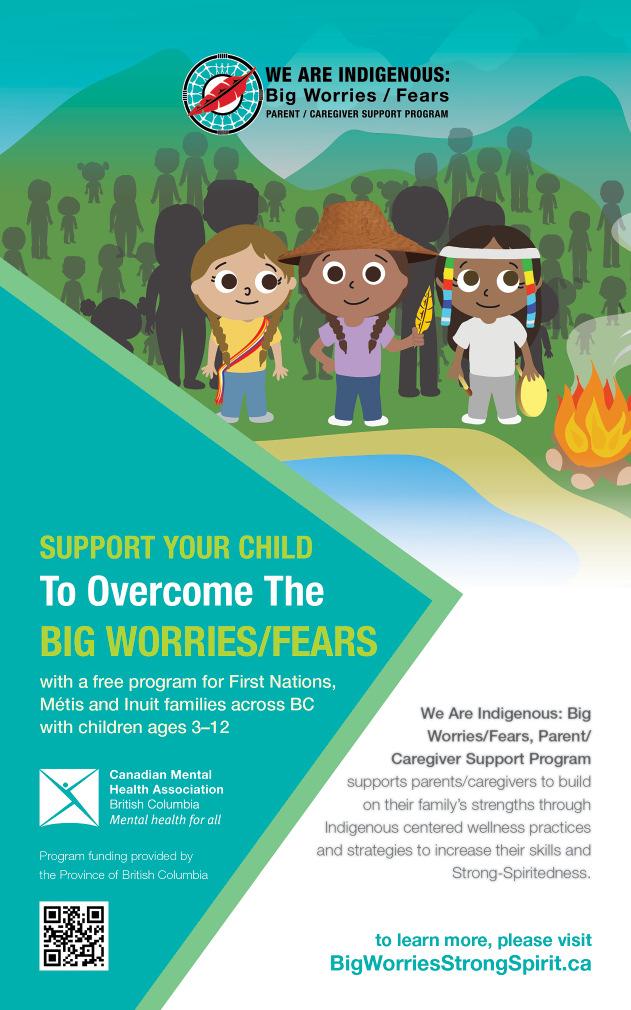
In March 2022, Tseshaht First Nation announced that it had hired a company to conduct drone mapping in areas near the former residential school site, now the location of Nuu-chah-nulth Tribal Council offices, Maht Mahs and other
Tseshaht buildings. The work was being done in preparation for ground penetrating radar scanning now being conducted in September 2022.
Mack recalled seeing something startling outside her home, back in March.
“The first day when they were doing the drones, mapping, that day I saw a human form walking from the park towards the bush,” she recalled.
It was a young boy; she estimates his age to be about 12.
“He was wearing black pants and white shirt, he kept looking back, like someone was chasing him,” she shared.
She remembered that it was near midnight, and in March, it was near freezing.
“I told Darcy [Mack’s spouse] that couldn’t be an actual child, it was 1C outside, and he had no jacket,” she said.
Concerned, Mack called around to nearby neighbors to ask if they’d noticed anything. But nobody else saw him, said Mack.
Then, six months later, the ground penetrating radar work was being conducted nearby.
“I saw the swings. There was no wind. No kids near. They had gone inside long before from recess,” said Mack.
She looked away to tend to her young daughter, she estimates for about five minutes. When she looked outside, the four swings were still moving.

“About ten minutes later they finally
stopped,” said Mack.
Mack believes that the start of the work to find possible unmarked graves is waking the little spirits.
“The spirits are wanting to be seen,” she said. “I think they are fromAIRS and they are now becoming free and they’re able to be seen. They want to be seen. They want to be guided back to spirit world. I feel like I was meant to see that.”
And many other Nuu-chah-nulth-aht share Mack’s beliefs. Her video, posted two days earlier, has more than 95,000 views and dozens of comments.
“Four little visitors at the park,” said Emmy Louise.
“Aww, precious babies, have fun,” said Emm Jay Gus.
“Woken spirits – wow!” said Karen Sutherland.
“They were found. They just finished the ground-penetrating radar. They are free,” said Haul Mack.
“They want to be seen and heard, too… not odd that it happened on a new moon,” saidAmanda Beth. “Country is waking up to the work we need finish, getting our loved ones where they need to be.”
Mack said that she was invited to the school playground later that afternoon, after school let out, to take part in a cleansing ceremony led by Tseshaht cultural workers. They were there to let the children know they are free to join the spirit world now. Ross asked Mack to join them for a cleansing at the park. They told the spirits that it’s time to go home.
“It’s bittersweet, it’s so sad,” said Mack.
“We don’t know why they died or how they died, but we know where they died. But they’re found now.”
Mack didn’t go to residential school, but her late mother went toAIRS.
“I feel really connected to all that’s going on. I feel for survivors. If my mom were still here, I’d want to support her as much as I could with all the work that’s going on,” said Mack.
October 6, 2022—Ha-Shilth-Sa—Page 7
Myra Mack video still Video taken by Myra Mack has drawn attention from thousands online, bringing thoughts of children who were lost at the Alberni Indian Residential School.
Orange fills poverty-stricken neighbourhood
One day prior to national day, Nuu-chah-nulth organize a walk to show a city’s vulnerable populations they are not alone
By Alexandra Mehl Local Journalism Initiative Reporter
PortAlberni, BC - One day prior to the National Day for Truth and Reconciliation, also a day recognized as Orange Shirt Day, orange fills lower 4th avenue as Nuu-chah-nuth walk through Port Alberni’s vulnerable neighborhoods handing out orange T-shirts.
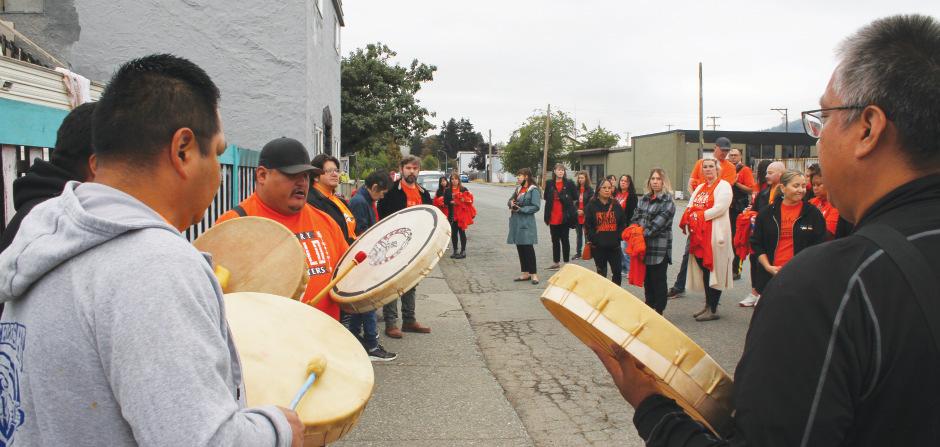


John Gomez, the Quu’asa coordinator for the Nuu-chah-nulth Tribal Council’s Teechuktl Quu’asa program, said the effort was to show the at-risk population that there are resources and support for them, and that they aren’t left behind.
It was reported that last year’s 24-hour homelessness count in PortAlberni found that individuals who identified as Indigenous made up 65 per cent of the total.

Jamie Richmond, Youth Outreach Worker for Nuu-chah-nulth Tribal Council (NTC) Harm Reduction Program, says it’s important for individuals in these vulnerable neighborhoods to know that the National Day for Truth and Reconciliation and Orange Shirt Day is for them too.
“Whether you’re on the street, [or] not on the street, we’re all one,” said Richmond.
September 30th marks the National Day for Truth and Reconciliation and Orange Shirt Day. The streets will fill with orange to recognize the harmful and ongoing impacts of residential schools and colonization.
“It’s important to also recognize that all Nuu-chah-nulth people, and Nuuchah-nulth related, have been affected by contact, colonization, and the whole process of assimilation. Which is the whole thing about orange shirt day; how residential schools have such a huge impact on our Nuu-chah-nulth population,” says Gomez.
Teechuktl Quu’asa provide programs, such as Nuu-chah-nulth Resolution Health Support Worker Program (RHSW), Quu’asa Community Wellness Program, and Harm Reduction Program, among others.
Cherie Elliot, resolution health support worker, says the impact of residential schools is that many Indigenous people are on the streets battling similar traumas.
“Alot of our Indigenous people may have not attended residential school, but they’re impacted by it because of their parents, their grandparents, [and] all the survivors,” said Elliot.
Historical trauma, also known as intergenerational trauma, is experienced by a group of people with a shared identity, and can be passed down through generations.
Elliot says thatAugust and September are difficult months for former residential school students because this is the time of year they would be taken from their homes.
“Today we just want positivity and be able to walk for them, walk with them whatever they may need for that day,” said Elliot.
“It’s generational. The effects are felt even in young youth today who did not attend, but maybe their grandparents did, or even their parents. It wasn’t that long ago,” Richmond said. “Whether they recognize it or not tomorrow, on September 30, it does, it affects them.
So just bringing awareness to days, like tomorrow, and the walk is super, super important, not just for survivors, but for [all] families.”
Kim Erickson, a youth outreach counsellor, says that traditionally homelessness was not experienced among Indigenous culture.
“Everybody had a role and everybody had a place and even the people who couldn’t contribute as much as others, they were still part of the circle – the sacred circle of our community and they belonged,” Erickson said. “Now we have so many people that feel they don’t belong.And they’re out here on the streets and they do feel alone… That is all directly an impact of colonization and genocide that has happened to our people across this country, Canada.”
Page 8— Ha-Shilth-Sa—October 6, 2022
Photos by Eric Plummer
On Sept. 29, staff from the Nuu-chah-nulth Tribal Council came to 4thAvenue, where the highest incidence of poverty can be found in PortAlberni. Pictured below is a property where accomodation in RVs is being rented at discount rates to those who have difficulty finding anywhere else to live.
‘Every child ma ers’ echoes through Port Alberni
Crowds walk for residential school survivors, truth and reconciliation, numbers almost doubled last year’s walk
 By Alexandra Mehl Local Journalism Initiative Reporter
By Alexandra Mehl Local Journalism Initiative Reporter
PortAlberni, BC - On September 30th, Orange Shirt Day, also known as National Day for Truth and Reconciliation, started at the Harbour Quay in PortAlberni with an overcast sky. “Every child matters,” echoed through PortAlberni while orange took to the streets.
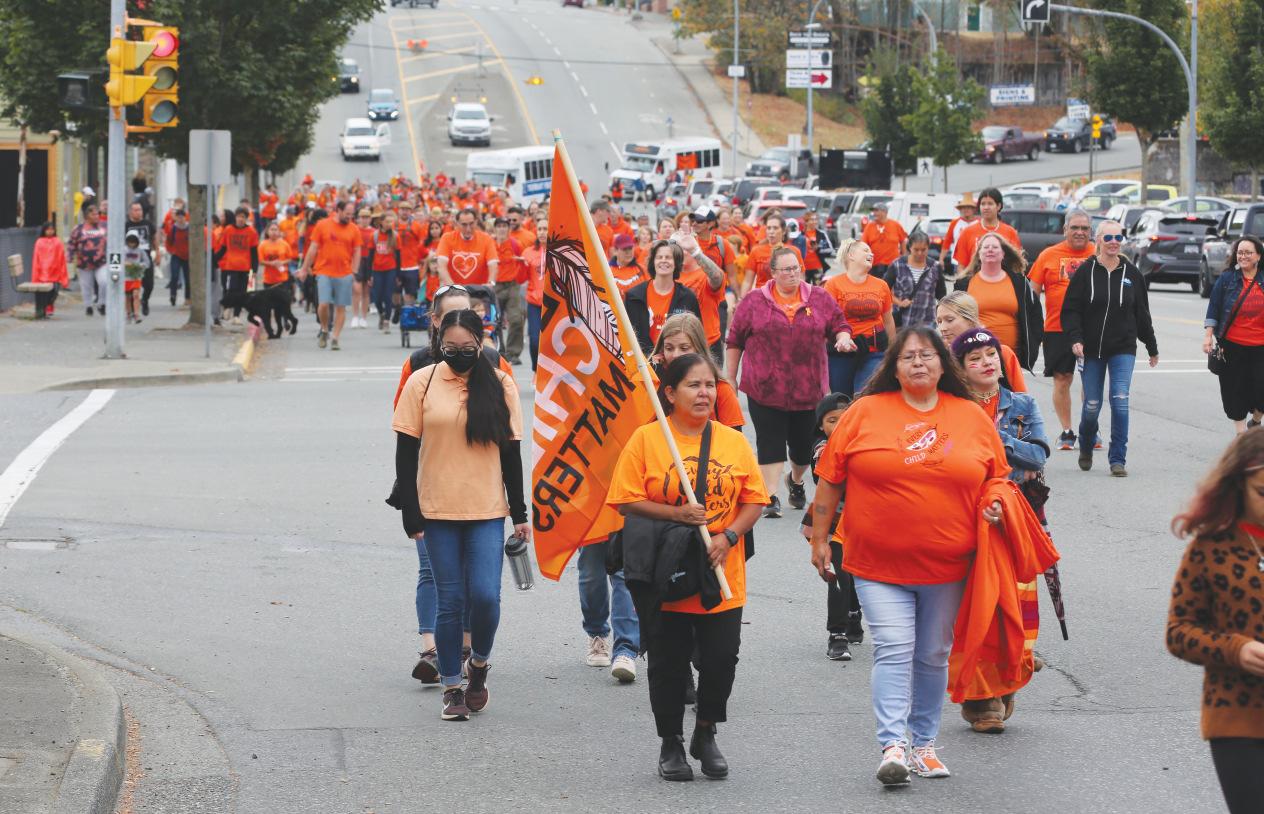
When Wahmeesh (Ken Watts), elected chief councillor of Tseshaht First Nation, arrived at the Harbour Quay he was taken aback by the number of people gathered in orange for the event.
“When we started [walking] and I looked down Kingsway [Ave]…it was literally shoulder to shoulder for the whole street,” said Watts. “It was pretty moving, not going to lie, like it’s pretty emotional when you see stuff like that.” Watts said this year the numbers seemed almost double to last year.
This year marked the second National Day for Truth and Reconciliation and the 10th Orange Shirt Day.
Orange Shirt Day is held to honor residential school survivors, and invoke meaningful conversations about the legacy of residential schools. It lands on September 30th because it was the time of year children would be taken from their family and placed in residential schools.
Phyllis Webstad, founder and ambassador for Orange Shirt Day, was six years old when her own bright orange shirt was taken from her at St. Joseph Mission (SJM) Residential School.
Many have joined this event, including allies showing up in solidarity.
Tour de Rock riders arrived in orange at Maht Mah’s parking lot while on their 14-day journey around Vancouver Island.
Tiffany Parton, executive director of the BCAssociation of Chiefs of Police, said, “Today, it was just really important
for us to honor and recognize this day, and pause our activities that we would normally have.”
The crowd of orange walked to Maht Mahs parking lot, the end of a sevenkilometer journey, in honor of survivors of residential schools. Once they arrived, the clouds had cleared to welcome the heat of the sun. There was a gathering around a fire for refreshments, stories, songs, and dances.
Watts said that there was a time where singing and dancing, potlatches, and
language was not allowed. “And we can still do it today because we’re resilient,” he said. “Survivors did survive.”
One of the speakers, Sim’ogit Tsa Bux (Chief Willie Blackwater) spoke to the crowd about the Blackwater Plaintiff role in truth and reconciliation.
In the early 1990s, Chief Blackwater along with 21 other survivors testified in the Blackwater v. Plint case. The BC Supreme Court delivered a judgment in favor of the Blackwater Plaintiffs for the
abuse they suffered while students at the Alberni Indian Residential School.
Alberni Indian Residential School (AIRS) was opened in 1891 as a day school. In 1973AIRS was closed by Tseshaht and other Nuu-chah-nulth nations, and in 1996 the last residential school closed in Punnichy, SK.
The Orange Shirt Day walk ended at Maht Mah’s gymnasium and the Tseshaht Longhouse where theAlberni Indian Residential School once stood.
Anumber of residential school survivors stood and spoke their stories to the crowd of people wearing orange.
“That’s why we walk, is for them now… it’s this society, it’s our job to help hold them up,” said Watts. “All the stuff they went through is real. It’s not made up… Many children never made it home and Kamloops didn’t just solidify that. People have known that we’ve been saying that for years. So that’s why we walk.”
In May 2021, the results of ground penetrating radar indicated that the remains of 215 children were found at the former site of the Kamloops Indian Residential School.
“It started at 215…” reads on the back of some of the orange T-shirts worn.
Over 4, 100 children were documented to have died while attending residential school, and 1,800 unmarked graves have been identified.
“It’s honoring survivors. But it’s educating Canadians and others [about] what really happened here, but it’s also showing that we’re resilient,” said Watts.
Kuu-us Crisis Line Society, established in August 1993, has a 24-hour culturally safe crisis line that can be reached at 250-723-4050 (for elders and adults), 250-723-2040 (for youth), and 1-800588-8717.
October 6, 2022—Ha-Shilth-Sa—Page 9
Photo by Eric Plummer
Awalk was held in PortAlberni on Sept. 30, on the National Day for Truth and Reconciliation, drawing hundreds to the streets. Pictured are walkers on 3rdAvenue.
Photo by Alexandra Mehl
ADSS buzzes with excitement for welcome gathering
By Alexandra Mehl Local Journalism Initiative Reporter
PortAlberni, BC -Alberni District Secondary School (ADSS) is buzzing with excitement as students, parents, and teachers gather to welcome the newest additions to the school, grade eights.
Jackie Chambers, one of the student success teachers atADSS, said the evening was an important way to connect students and families to the high school.
“We have a chance to show them that we’re really happy that they would come and have some food with us,” said Chambers. “We get to meet parents with their children…that connection is then made, and that just makes for a positive start to the school year, you know, and their schooling career, actually.”
Chambers says that this event brings connection between home, community, and school.
This is the first time the Welcome Barbeque was hosted for the new Grade 8 students since 2019.
Jeannette Badovinac, vice principal of ADSS, said she is looking forward to help kids build their foundation so they can be successful in whatever they hope to do.
Badovinac said one of the major roles as vice principal is to support Indigenous programs.
“We’ve done a lot of work in the last couple of years to really increase our cultural awareness and the presence of culture in our schools so that our students see themselves reflected in our building when they come here,” said Badovinac.
Alberni District Secondary has worked to include a number of resources for Indigenous students, including three student success teachers, two mental health and wellness workers, and two Nuu-chahnulth education workers. Newly added this year is an Indigenous support worker whose primary role is to connect with and re-engage students who have been disengaged in their schooling over the last year and a half of the COVID-19 pandemic, said Badovinac.
Shelley Frank, a Nuu-chah-nulth education worker atADSS, said, “What I do is I bring culture, I bring knowledgewhatever I can to bring them back into
Recently students worked on a project (above) to commemorate elders and loved ones who have passed on. Moira Barney (below), a language teacher and co-chair for the Indigenous Leadership Team, speaks to students and families at the event.
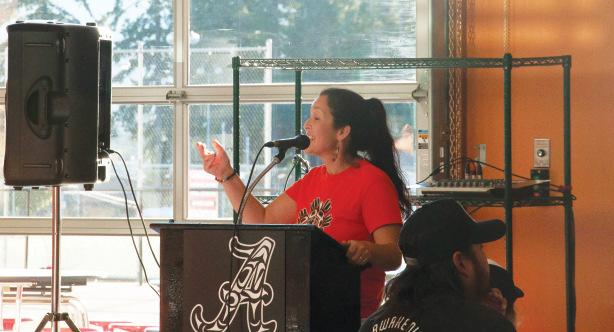
their teachings.”
It was December of last year when Frank started as a Nuu-chah-nulth education worker, when COVID-19 precautions were still in place.Asmall group of students used construction paper for cedar bark weaving and to making canned salmon, among others. With this project, Frank and the students spoke about potlatch, traditional cedar weaving, and canning salmon.
“We try to reground them and show them their roots of their strengths,” said Frank.
Recently Frank and her students worked on a project to commemorate elders and loved ones that have passed on. Prompted by one of the students, the class wrote the names of loved ones that had passed onto ribbons and orange sewn flowers. One was left blank to commemorate individuals that were not mentioned.

Frank said students that are coming to ADSS are third and fourth generation residential school survivors.
“Truth and reconciliation is something that we’re going to work on, not just this month,” said Frank. “The whole year,
we’re going to carry it out, and make sure that we’re learning constantly about the truth of the dark history of Canada, to where we are now, to what we could do to change and reconcile in the future.”

“We just want Indigenous students to feel like this is their home, and then once they have that sense of belonging, to be able to build on that, and the success on teams and the success academically,” said Moira Barney, language teacher and co-chair for the Indigenous Leadership
Team.
Badovinac said staff atADSS are here to support students, encouraging students to come see them when they need help and support.
“The biggest thing I would say is we care so much about [our students].And we do this job because we care [and] we want to help them really thrive and become the best version of themselves that they can,” said Badovinac.
Page 10— Ha-Shilth-Sa—October 6, 2022 Illustration by Ivy Cargill-Martin Phrase†of†the†week:†ʔuqmisʔišʔał ḥuutaksuup t’at’naaʔiš, naay’aq’ak q’uuquʕaqsa Pronounced ‘Ooh k mis ish alth who r taak sup tat na ish nah ya ask koo koo ugh saa’, it means, ‘It’s lot of fun to teach our young babies our own language. ’ Supplied by ciisma.
High school works to be er reflect its high Indigenous population, with additional supports to help students
Photos by Alexandra Mehl
Science of smokehouses studied at Learning Centre
Students research, design and build a traditional smokehouse, incorporating multiple elements of curriculum
By Denise Titian Ha-Shilth-Sa Reporter
PortAlberni, BC – The students of 8th Avenue Learning Centre, which offers an alternative education program for high school, will soon be building a Nuu-chahnulth-style smokehouse on the grounds of the school thanks to a grant from Community Futures Fund.


Principal Dave Maher is excited about the project, saying that it will tie in with existing school programs. It will engage the community as students will be required to interview Tseshaht people that have and use traditional smokehouses. Nuu-chah-nulth Education Worker Tamiko Rampanen will facilitate the work that will take place between the school, students, and the people of Tseshaht.
“This is an incredible cultural opportunity; it is hands-on learning where the community becomes the textbook,” said Maher.
According to Maher, the smokehouse will be built on school property, near their Life Garden.
The students, with assistance from Rampanen, will tour Tseshaht smokehouses and interview the owners about construction styles. From there they will draw designs. The lumber is ready to go, and the smokehouse will be built by two small teams of students.
“This is not only a cultural lesson, but also has mathematic and scientific elements – they will be required to do online research and in-person interviews as part of the language arts program,” said Maher.
Once complete, the Learning Centre’s fishing program will be incorporated into the smokehouse.
“In 2021 we did a freshwater fishing program where the youth picked up tools and techniques to harvest freshwater fish in rivers and lakes,” said Maher.
The next step is to expand the program to include the harvest of saltwater fish.
The students learn a variety of methods to harvest fish from recreational rod and reel to commercial fishing techniques, thanks to partnerships with First Nations and local agencies.
With the smokehouse, students will
learn to cut, prepare and preserve fish by smoking and/or canning. Students from local elementary schools will drop by on field trips to observe the work being done on the smokehouse as part of their learning process.
Maher says it’s about food sustainability. With the help of community mentors, students will learn how to catch, prepare and preserve their fish.
Partners for the program include the NTC’s Usma Nuu-chah-nulth Family and Child Services, School District 70 and theAlberni Drug &Alcohol Prevention Service. Community Futures provided a grant of $6,000 for the project.
“It’s a great project and I’m grateful for the community support; we’re very excited about it,” said Maher.

October 6, 2022—Ha-Shilth-Sa—Page 11
Photo by Eric Plummer David Maher, principal of the EightAvenue Learning Centre, prepares to smoke salmon with student Cameron Mar. The school plans to build a traditional Nuuchah-nulth smokehouse, based on interviews with people from the Tseshaht community.
Health Corner
October is Breast Cancer month
Breast Cancer signs and symptoms

Breast cancer may not cause any signs or symptoms in its early stages. Signs and symptoms often appear when the tumour grows large enough to be felt as a lump in the breast or when the cancer spreads to surrounding tissues and organs. Other health conditions can cause the same symptoms as breast cancer.
The most common symptom of ductal carcinoma is a firm or hard lump that feels very different from the rest of the breast. It may feel like it is attached to the skin or the surrounding breast tissue. The lump doesn’t get smaller or come and go with your period. It may be tender, but it’s usually not painful. (Pain is more often a symptom of a non-cancerous condition).
Lobular carcinoma often does not form a lump. It feels more like the tissue in the breast is getting thicker or harder.
Other symptoms of ductal and lobular breast cancer include:
a lump in the armpit (called the axilla)
changes in the shape or size of the breast
changes to the nipple, such as
a nipple that suddenly starts to point inward (called an inverted nipple)
discharge that comes out of the nipple without squeezing it or that has blood in it
Late signs and symptoms occur as the cancer grows larger or spreads to other parts of the body, including other organs. Late symptoms of breast cancer include:
bone pain
weight loss
nausea loss of appetite jaundice
shortness of breath cough headache double vision muscle weakness
Source: Canadian Cancer Society
Events

Obituaries
“Con Charleson (mit) leaves a legacy of strength, leadership and resilience”
It is with heavy hearts that the family of Constant Napoleon Charleson announce the passing of their loving husband, father, Grampa, Great Grampa, son, brother, uncle.
Constant was born onApril 19, 1952 and died suddenly at 70 on Sept. 4, 2022. Constant was known to many as ‘Con’, ‘Connie’, or by his nickname ‘Nupps’. Con’s cultural name was ʔaawiłqum, which means to take something. Con was born to Patrick Charleson Sr and Mamie Charleson (mit) nee John on April 19, 1952 at Hot Springs Cove, BC. Con had 14 brothers and sisters and came from a rich lineage with roots extending to Hesquiaht, Mowachaht, Shıshahl (Sechelt), Muchalaht, and Ehattesaht. From a very young age Con was known as Kunčʔpa (meaning, tough guy). Con lived up to this name.At age 6, Con was forced to attend the Christie Indian Residential School on Meares Island then transferred to St. Mary’s Indian Residential School at Mission, BC. When he was 14 years old he put “the largest nun in the world”, Sister Peter Damian, in a head lock because she was abusing children.
After being expelled, Con went back to Hot Springs Cove where he began logging at 15 & became a Hook Tender at 16. Con moved to PortAlberni & worked in logging for Macmillan Bloedel. Con eventually followed his passion in salmon fishing. He captained 11 seine boats, was a commercial marine diver, and was known as a high-liner during his 50-year seining career. Con was in the process of purchasing his father’s seine boat, M.V. Princess Colleen, which he captained for the last 6 years.
Con was an advocate for Native fishing rights and wild salmon.Active in the Nuu-chah-nulth fisheries litigation, he
fought for the right to fish commercially.
Con played a role in the T’aaq-wiihak Fishery, was a director on the Ha’oom Fisheries Society board & a lead negotiator for the Hesquiaht Nation.
Con spent the past 30 years residing in Huupachasath territory, during which he spent 20+ years as a deckhand with his wife and children food fishing in the Somass River. Con generously gave fish to people in need. He also shared his fishing knowledge with others who were just beginning. Con demonstrated leadership in many areas of life, including the past 15 years as a Band Councillor for Hesquiaht.
Growing up, Con was an athlete passionate about basketball. He led as a player/coach for the Hesquiaht Braves.
Over 26 years he organized the largest all native basketball tournament in southern B.C., the Hesquiaht BravesAll Native Basketball tournament in PortAlberni.
Con also loved fast pitch and spent years pitching for his team, the Hesquiaht Braves, and playing for Wyac, an all native team that won the championship at PortAlberni’s uptown league.
Throug his life, Con stood up for people. Con had 6 children withArlene Howard, 1 child (predeceased) with Tess Hansen, 1 child with Julia Joseph and 5 children (1 predeceased) with Heather Joseph.
Con leaves a legacy of resilience, as a survivor, an athlete, an activist, an advocate, a leader and more importantly a husband, father, grandfather, great grandfather, son, brother, uncle.
He is dearly missed by his wife Heather Joseph, 11 children, 28 grandchildren, 19 great grandchildren and numerous family and friends. His family takes comfort in knowing he has gone home and is with the ancestors. ƛeekoo ƛeekoo to family, friends, and community for your love and support during our family’s time of need.
“Love you all.”
Page 12— Ha-Shilth-Sa—October 6, 2022
Employment and Training




Port Alberni Friendship Centre
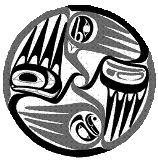
October 6, 2022—Ha-Shilth-Sa—Page 13
Volunteers Needed Need work experience? The Port Alberni Friendship Centre is looking for interested applicants for various positions. Call 250-723-8281 More job postings at www.hashilthsa.com
Forestry MOU juggles protection and employment
2022 was quiet for protests near Fairy Creek, but the protection of a rare lichen species could slow harvesting
By Denise Titian Ha-Shilth-Sa Reporter
Port Renfrew, BC – Pacheedaht First Nation has signed a Memorandum of Understanding with Teal Cedar Products Ltd. that they hope will build on an existing relationship between the nation and the company. Chief Jeff Jones says the MOU, signed Sept. 8, will facilitate dialogue between the parties allowing them to explore economic development opportunities while balancing PFN interest in stewarding the lands water and resources of its territories.
“It’s been a long time coming,” said Jones, adding that various forestry companies have had ownership of TFL 46 for seven or eight decades, mostly leaving PFN out of management decisions.
The Teal-Jones Group, a forestry products company based in Surrey, BC, is proud of its relationships with its Indigenous partners.
“Teal Jones has a history that includes productive working relationships with 106 First Nations in B.C. Each relationship we form reflects the distinct interests of the individual First Nation,” they state on their webpage. “We believe that it is of paramount importance to work closely with our Indigenous partners to ensure your Nations’success as well as our own. Economic and social wellbeing are our goals.”
The MOU aims to bring the parties together to create a framework agreement to “facilitate dialogue and identification of opportunities for economic development in balance with continued stewardship of the land, water and resource on Pacheedaht First Nation traditional territory,” reads the joint press statement.
“This (MOU) will give us a say over the territories of our hereditary chief, Frank Jones,” said Jeff Jones.
Forestry companies have been harvesting Pacheedaht territories for about 80 years, Jones estimates. He said he is grateful that the major players came to a form of understanding regarding Pacheedaht interests in forestry in their territories.
“This partnership builds on the existing relationship created over the years, and we will work together for the betterment of both sides,” said Jones.
The agreement provides forestry training and employment opportunities for Pacheedaht members – longer, more stable employment opportunities as opposed to seasonal work in the tourism industry. In addition to forestry opportunities, the parties will work together to explore business, commercial and other employment opportunities.
80 per cent of Fairy Creek protected Jones says the agreement will maintain Pacheedaht cultural values, such as protecting stands of old growth cedar.
According to Jones, about 80 per cent of the Fairy Creek watershed is protected under their Integrated Forestry Management Plan.
“One hundred, two hundred…four hundred years down the road our Pacheedaht people will have access to old growth cedar; we have areas set aside for canoe logs,” said Jones.
He went on to say that the parties are working to maintain the integrity of forest resources for future generations in TFL 46.
The village of Port Renfrew grew up as a logging community. It was forestry companies that brought houses in for
their workers to raise families.
“In the ‘70s, ‘80s, ‘90s, Pacheedaht had a presence in the logging industry, but when the forestry camp was gone in the ‘80s the jobs were gone, too,” said Jones.
In recent years, Pacheedaht built a sawmill to create local jobs by milling the raw materials they have in their territory.
The mill is capable making beams as long as 60 feet, according to Jones. But it needs old growth logs or mature second growth to operate.

“We have a cedar strategy that involves all tenure holders in our territory and we have a log market agreement with Teal – we purchase logs from them for our mill,” said Jones.
“Today, we have five people working at the sawmill,” he added.
With the signing of the MOU, Pacheedaht people will have opportunities to train or work in all aspects of forestry management.
“From identifying culturally modified trees, silviculture to mapping – maybe we’ll even have land guardian presence so our youth can learn about their territories,” said Jones.
According to Jones about 70 to 80 per cent of TFL 46 is in Pacheedaht territory.
“Our goal is to have as much ownership in our territory as possible,” he said.
The nation is taking steps in that direction starting with the purchase of local fee-simple lands, including Browns Mountain. The vision is to eventually move Pacheedaht people out of the lowlying tsunami zone up the mountain.
Aquiet year for protestors
As for the anti-logging blockades, they did not have a presence in Port Renfrew in the summer of 2022. The Rainforest Flying Squad have set up encampments at the side of the road leading up to the Fairy Creek watershed for the past two years. The Teal-Jones Group filed a court
injunction to have the blockades removed and over 1,000 arrests were made in 2021 as activists were removed by the RCMP. Reports say that nearly 1,200 activists were arrested in the blockades.
Chief Jones says it’s up to Teal-Jones Group and law enforcement to manage protestors.
“Pacheedaht has respectfully asked them to leave several times and we committed to the two-year deferral and to get our Integrated Forestry Management Plan up and running,” said Jones.
According to the provincial government, the Ministry of Forests is working in partnership with Indigenous nations to defer logging activity within 2.6 million hectares of B.C.’s most at-risk old growth forests.
Included in the deferral process is 1,119 hectares of the Fairy Creek Watershed, 884 hectares of which is designated old growth.
“Approved short-term deferrals will help protect and support these ecosystems while First Nations, the province, and other partners develop a new approach for old growth forest management,” according to the BC Ministry of Forests website.
Grateful that they are gone, Chief Jones says there is no reason for protestors to occupy Pacheedaht territory.
Rare lichen discovered While groups are currently not blockading in the First Nation’s territory, they have changed tactics. Environmentalist activist Joshua Wright claims to have found a rare lichen called Oldgrowth Specklebelly on Sept. 13, near Port Renfrew on the Bugaboo Main logging road. He says there are only 56 documented findings of this unusually colored, pale green-blue species of lichen in Canada. Wright documented five host trees and forwarded the information to the govern-
ment, hoping they will offer some protection through its commitment to biodiversity conservation.
The Rainforest Flying Squad states that the future of the lichen now hinges on the provincial government’s decision to approve the cutblock. In a press release the group said, “Scientists fear the province will fail to adhere to its own management plan to protect the rare lichen.”
Trevor Goward, a lichenologist who named the Oldgrowth Specklebelly and assisted the B.C. Ministry of the Environment with its management plan of the species, questions how the cutblock could have been approved by Teal-Jones for logging.
“How is it possible that an in-your-face lichen like Oldgrowth Specklebelly, a species listed under Canada’s Species-AtRiskAct, went under the radar?” he said in the Rainforest Flying Squad’s press release.
Jones said Pacheedaht will consult with a professional biologist to investigate the lichen’s presence in the cutblock. Based on the findings of their biologist, the nation will make decisions on how to proceed.
“If a rare lichen species is found in our territory, it will be included in our Integrated Resource Management Plan to ensure responsible stewardship of at-risk species and ecosystems within our nations’traditional territories,” he said.
Chief Jones called the MOU a step in the right direction.
“Revenue from forestry partnerships bring local benefits,” said Jones, like annual Christmas disbursements to members and funds to purchase fee-simple properties for the benefit of all Pacheedaht people. “This agreement provides a respectful understanding and that’s what’s important to Pacheedaht.”
Page 14— Ha-Shilth-Sa—October 6, 2022
Photo by Denise Titian Pacheedaht First Nation Chief Councillor Jeff Jones watches an old-growth cedar log being cut at the First Nation’s sawmill in Port Renfrew, as Makah master carver Micah McCarty stands next to him and apprentice Trystan Dunn-Jones, Jeff Jones’son. The cedar log was used to make a traditional canoe.
‘There’s a great deal of truth telling still to be done’
Podcast reveals First Nations stories, hosted by a former director of the Truth and Reconciliation Commission
By Konnor Oliver Ha-Shilth-Sa Contributor
Victoria, BC- Described as a “new podcast about memory, power and the journey to find truth,” Taapwaywin: Talking about what we know and what we believe is the latest project from the University of Victoria Libraries. Hosted by associate university librarian Ry Moran, the podcast aims to speak with elders, knowledge keepers, and others from both Indigenous and non-Indigenous communities to tell stories and highlight the experiences of Aboriginal people.
Truth has been a focus for Moran for many years now, spending time as director of statement gathering for the Truth and Reconciliation Commission and director of the National Centre for Truth and Reconciliation.

“I’ve talked to a lot of people across the country, and I’ve been asked a lot of questions,” says Moran. “The podcast in many ways is an effort to dig deeper into some of those questions that I’ve been asked, to provide a bit more substantive response to some of those questions and to try to bring some really important voices forward… that can help them unpack these questions further.”
Seven years have passed since the closure of the Truth and Reconciliation Commission, and Moran says that makes this the right to time to start Taapwaywin.
“We’ve got to be thinking about what success we’ve collectively achieved in regards to implementation of the Calls to Action and our increase of knowledge, while also very firmly keeping our eyes
Ry Moran hosts the eight-episode series Taapwaywin: Talking about what we know and what we believe.
focused on the path forward and the journey that lay ahead,” explained Moran.
Moran says that while the lasting impacts of residential schools on Indigenous communities in Canada are numerous, one of the less recognized ones is the silencing of their voices even through to today. Moran believes that his podcast will provide a place for those voices to be taken back.

“We are extricating ourselves from this
process of deliberate misinformation and the overt exercise of power onto Indigenous peoples,” he said. “And in telling the stories that need to be told and in giving space to the voices that need to be heard, we are actively combating that process of erasure that Canada is very much founded upon and continues to be largely ignorant of actually.”
The first episode of the podcast discusses that very topic. Moran is joined by
Tla-o-qui-aht elder Dr. Barney Williams, Paulette Steeves, Canada’s research chair in healing and reconciliation atAlgoma University, University of Victoria’s VicePresident, Indigenous, Dr. Robina Thomas, and Michif elder Norman Fleury.
Moran acknowledges that for some listeners, it may be difficult to listen to the topics discussed in some episodes.
“If you listen to the very first episode, when we talk about some of the findings that were released by the Truth and Reconciliation Commission, including findings of cultural genocide and mass human rights violations and failures those are realities, they are painful to confront and they are also important truths that need to be acknowledged, and in many ways represent a starting point in the conversation,” Moran said. “There’s many other starting points of this conversation, but they represent a starting point.”
He also encourages listeners to take care when listening, and to engage with the content in a way that minimizes harm.
Left out of the subtitle for the show, talking about what we know and what we believe, is a third part which Moran believes to be just as important as the other two.
“The podcast, I think, is very much grounded within a search, an exploration of the questions, not the answers,” said Moran. “We don’t have all the answers, that’s for sure. But the questions are really important and it’s really important that we’re asking these questions.”
The series is available on major podcast platforms and on the website Taapwaywin.ca.
October 6, 2022—Ha-Shilth-Sa—Page 15
Photo by Chad Hipolito/UVic photo
NTC Education Department News - meet our team
My name is Tamiko and I am from cišaaʔatḥ Nation


From the Waès and Gallic family.
My name is ciyaqapt, Shelley Frank from Ahousaht BC and I work as a NEW at Alberni District Secondary School.

Eva works at Gold River Secondary School.
My posiùon is a Post Secondary Counsellor. I feel blessed to be in this role, I am here to provide guidance and support to students.
Sheila works at Zeballos Secondary School.
Miss Jean works at Tsuma-as. and my qu-as name is wiica and I am c’ishaa-aqsup;.


Mrs. Sanders works at John Howiè and Wood Elementary School. In the schools, students and parents know me as, Mrs Sanders. I am from diùdaht.

Ms Irene works at Alberni elementary Scool. I am from Kyuquot.
Ms Jen works at EJ Dunn. Daughter to Susan Wale, Granddaughter of Iva Kiayawasew. Sturgeon Lake Cree Naùon Alberta.


Daisy works ay Kyuquot Elementary School.
I am Marsha Maquinna from mowachat muchalaht first naùon at Ray Watkins Elementary.
Ms Tom works at Maquinna Elementary School. From Tlao-qui-aht
Aaron works at Alberni District Secondary School.
Angela works at Ucluelet Secondary School.
Darlene works at Wickaninnish Community School. I’m from Tla-o-qui-aht First Naùon.



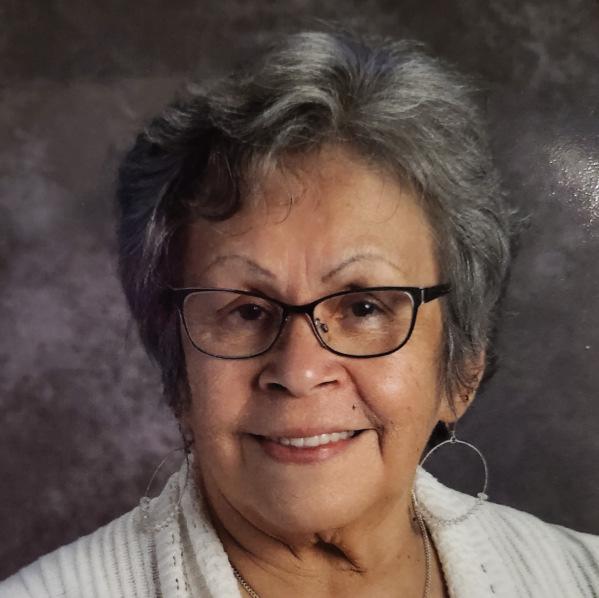
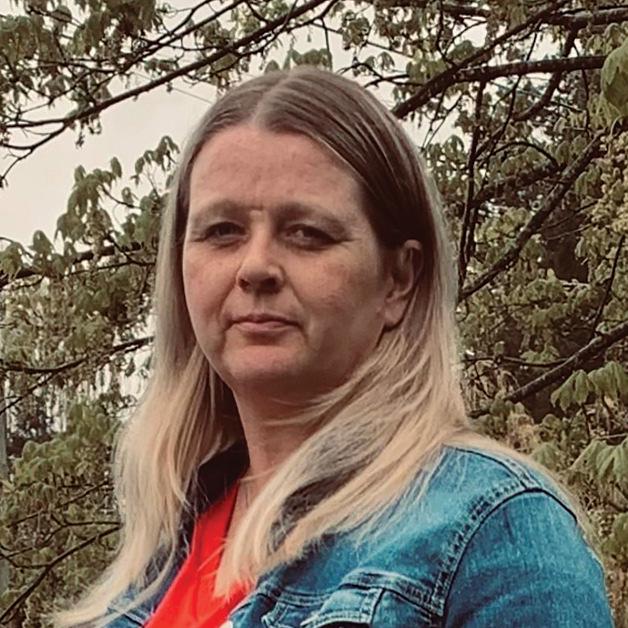

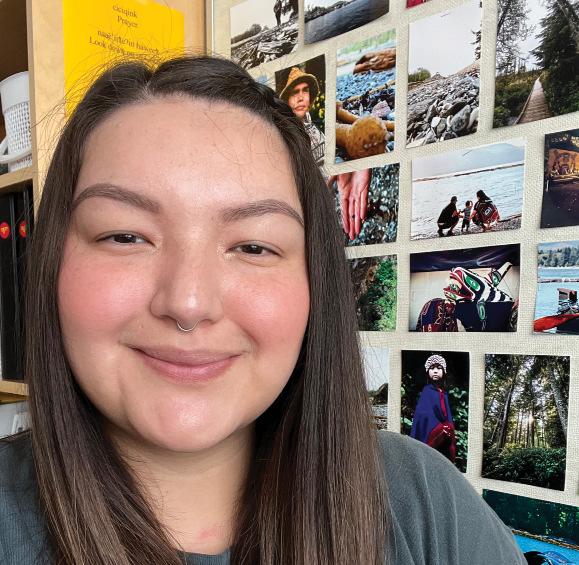
Page 16— Ha-Shilth-Sa—October 6, 2022
Kirsty Allen
Jennifer Lambert
Jean Thomas Iris Sanders
Tamiko RampenanShelley Frank
Marsha Maquinna
Irene Joseph Alexandria TomDaisy Hanson
Eva Johnson
Sheila John
Aaron WattsAngela TitianDarlene Frank





















 By Alexandra Mehl Local Journalism Initiative Reporter
By Alexandra Mehl Local Journalism Initiative Reporter































